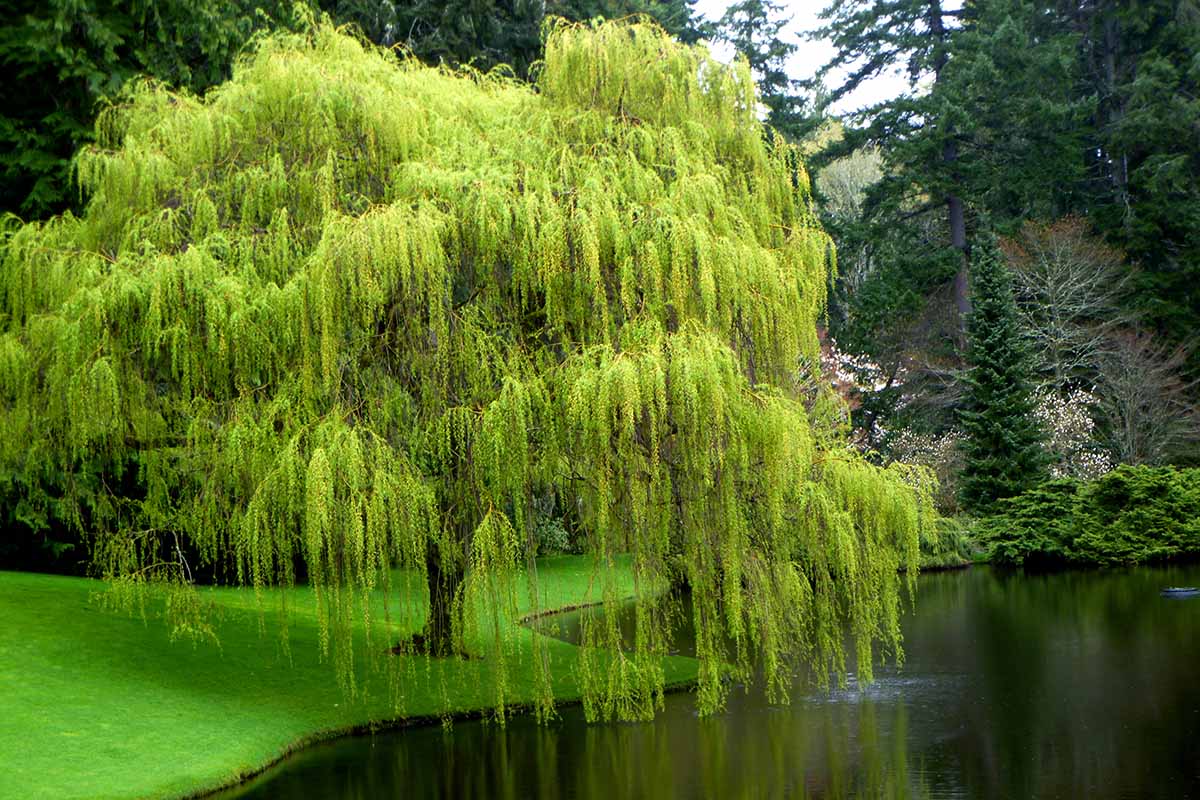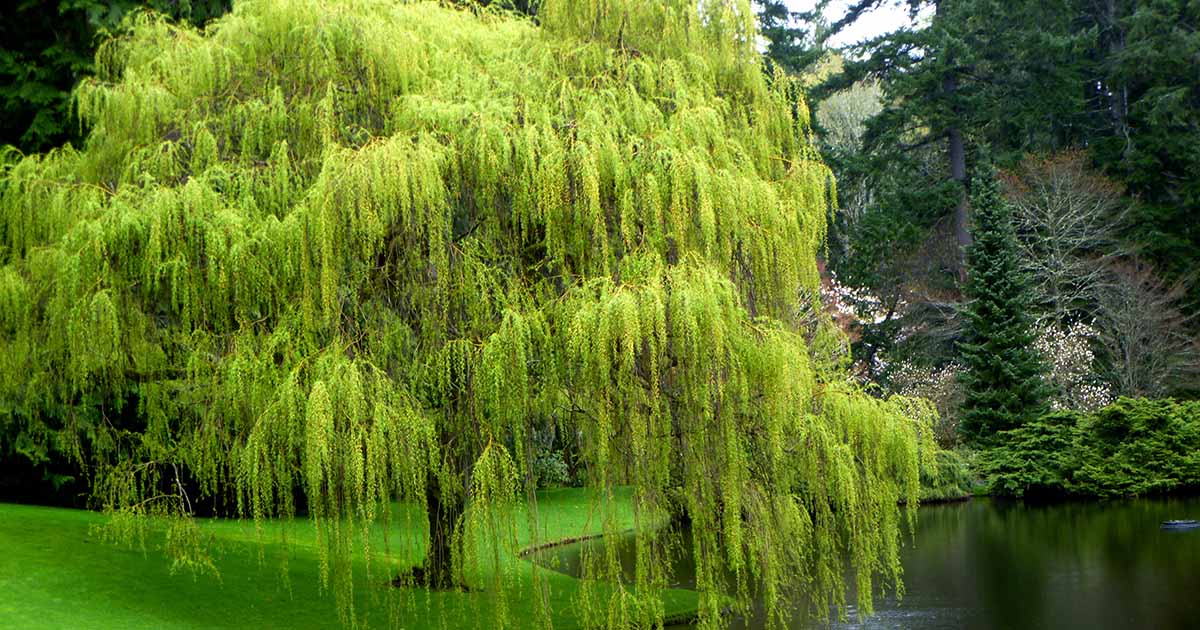The majestic weeping willow, Salix babylonica, is a deciduous tree for Zones 5 to 9 that displays gracefully arching branches and delicate, lance-like foliage subtly adorned with pendant yellow catkins in the spring.


We link to vendors to help you find relevant products. If you buy from one of our links, we may earn a commission.
Cultural requirements include a full sun to part shade location, ample moisture, and acidic to slightly alkaline, well-draining, sandy loam.
Mature dimensions can reach up to 80 feet tall and wide.
Our guide to growing weeping willows has all you need to cultivate this exquisite landscape tree in your outdoor living space.
This article discusses whether or not you should prune weeping willows.
Here’s what we’ll cover:
Pruning Weeping Willow Trees
Let’s begin.
Why Prune a Weeping Willow?
Seven common reasons for pruning S. babylonica are:
- Improve Structural Integrity
- Eliminate Crossing and Reduce Density
- Establish a Central Leader
- Promote Balanced Growth
- Remove Branches that Obstruct
- Repair Winter Damage
- Reshape for Aesthetics
Let’s talk about each.
1. Improve Structural Integrity
Weeping willows grow quickly, putting on about three to four feet each year, until they reach maturity, which takes about 20 years.


Unfortunately, rapid growth often results in brittle wood and weak branch collars, where the branches join the main stem.
Gardeners who begin trimming annually at the sapling stage, starting at the age of three, improve structural integrity, reduce the risk of breakage, and extend the life of the branches.
2. Eliminate Crossing and Reduce Density
As a weeping willow sapling grows, many branches sprout to form a dense canopy.
Some cross over each other, rubbing and opening the outer cambium layer, rendering the wood beneath vulnerable to breakage and the ingress of pathogens and pests.
The removal of crossing branches eliminates rubbing and improves airflow essential to inhibit the development of fungal pathogens that thrive in moist areas with poor air circulation.
3. Establish a Central Leader
During the early years, a weeping willow sapling may develop multiple trunks.
Without a single central trunk or leader, the tree will not look at its best, but more importantly, the main stems may split off from each other, causing fatal damage.


Trimming branches to establish and maintain a single central leader results in a well-balanced, aesthetically appealing display.
It is also necessary to snip off any suckers that grow on the leader to avoid the growth of competing trunks.
If suckers are a persistent problem, you may need to consult an arborist to determine the cause.
4. Promote Balanced Growth
Establishing one central leader and horizontal limbs as well as spacing canopy branches to prevent rubbing and improve circulation go a long way toward promoting balanced growth in young specimens.


For mature specimens, the removal of old, heavy limbs is essential.
An arborist can ensure that weight is evenly distributed by the well-balanced cutting of limbs and canopy thinning.
5. Remove Branches that Obstruct
A weeping willow often grows on the banks of streams, idyllically brushing the water’s surface and sinking its roots into the moist soil it craves.


Unfortunately, other specimens find themselves in yards where their sweeping branches block sidewalks and driveways, and require trimming to prevent causing obstruction.
To maintain a naturalistic appearance, resist the urge to gang-cut with loppers and instead, use shears to shorten each stem in a more random fashion, maintaining the natural “weeping” appearance of the branches.
6. Repair Winter Damage
Winter conditions, including cold, wind, and the weight of snow, may cause wood to break or die and require removal.
Damaged and dead wood is vulnerable to pests and pathogens which can harm the tree. Remove it before the growing season resumes in the spring to avoid infestation and infection.
7. Reshape for Aesthetics
Once a tree matures, gardeners may wish to prune periodically to remove wayward branches that detract from the overall balance.
Photograph the branches when they are leafed out in season and withhold trimming the offending ones until the following winter when the sap is dry.
When to Prune Weeping Willows
It’s best to prune a weeping willow in late winter. With growth at a standstill, the sap is dry and the foliage is absent.
Trimming at this time does not shock the tree, the gardener can see the branches clearly, and there is no sticky mess from the sap.


If you miss the late winter window of opportunity, you can also prune in early spring, but the longer you wait, the more sap will be produced.
Equip yourself for the job by wearing a hat, long pants, long-sleeved shirt, safety glasses, and sturdy shoes or boots.
You may also need a stepladder, depending on the size of your weeping willow.


Sanitize the blades of an extension saw, long-handled pruners, a pruning saw, and pruning shears with rubbing alcohol or a ten percent bleach-to-water solution (one part bleach to nine parts water) before and after use to avoid spreading garden pathogens.
If your tree is too large to reach the top comfortably, or the boughs are unwieldy, schedule pruning with a professional arborist instead of trying to tackle it on your own.
Trimming Tips
Refer to the following seven tips when planning to trim your trees:
1. Follow the One-Third Rule.
The first rule of pruning is never remove more than one-third of the total volume of a tree to avoid severe shock and a possible failure to recover.
Do this by removing every third branch or cutting off one-third of the terminal twig growth. Your choice will depend on what your tree needs.
2. Use the Right Tools for the Job.
Use shears to cut slender branches at a 45-degree angle just below a leaf or twig node, a natural growing point.
For thicker wood, use an extension or pruning saw. Start cutting upwards from underneath the branch, then make a second cut from the top cutting downward.
After the limb falls, clean up the jagged stump by slicing it off as close to its point of origin as you can without scraping bark off the main lateral or leader.
3. Strive to Improve Airflow
If you are removing some branches to aerate the canopy, you can remove every third branch to its point of origin.
Ideally there will be a few inches between branches to promote good airflow.
4. Cut Selectively for an Irregular, Natural Look
To shorten twigs that brush the ground so you can set lawn chairs in the shade, you’ll want to remove no more than the bottom third of all branches.
To avoid the “umbrella” look, cut individual twigs with shears rather than using loppers to cut multiple at once, and vary the lengths a bit.
5. Retain Reliably Strong Horizontal Limbs
Once you have a central leader established in a sapling you can begin to scout for lateral branches that will provide balance.
The best ones to encourage are those that join the leader with more of a “U” shape than a “V” shape.


The more horizontal the crotch at this junction, the stronger the lateral limb.
Those shaped like a “V” are more likely to cleave and snap off in strong winds, and these should be removed.


If you have a mature specimen, examine it for “V” limbs that may be heavy and likely to break. An arborist can remove them and thin the canopy to distribute the remaining weight evenly.
6. Retain Downward-Pointing Crossed Branches.
With an upright central leader and main horizontal boughs established, you’ll need to address branches crossing one another.
Remove those that have become damaged from rubbing together by cutting them at their point of origin.
If they are crossed with no bark damage, retain the ones that point downward in the straightest fashion and remove the more horizontal ones.
7. Remove Damaged, Diseased, and Pest-Infested Wood
Don’t wait for late winter to cut away wood that is broken, dead, infected, or infested. Waiting too long to remove it may lead to more extensive damage.
In addition to the tips above, there is another, more drastic type of pruning called “pollarding.” Let’s discuss that next.
What Is Pollarding?
Pollarding is an extreme form of pruning that removes all crown branches and retains just the central leader and main lateral limbs.
It creates well-sealed “knuckles” that prevent moisture from penetrating and rotting the trunk.


When young trees – 15 years of age or less – are pollarded, the new growth is removed to the knuckle annually. They regrow quickly.
For mature specimens, pollarding should take place every three to five years because regeneration is slow.


The technique enables gardeners to minimize unwanted encroachment over sidewalks and roads, create a smaller shade-casting canopy in home landscapes, and maintain a consistent, manageable height and width.
Consult a professional before attempting the pollarding method yourself.
Pruning to Benefit Saplings and Seniors
If you have a young tree, you should prune it regularly to develop a single central leader, stable horizontal limbs, and a well-balanced, aesthetically pleasing form.


Depending upon the early care received, if you have an older tree you may have to prune it to remove aged limbs and maintain the desired height and shape.
In the case of very large mature specimens you may need to consider hiring an arborist.
Make sure you always remove damaged, dead, diseased, or pest-infested wood.
Does a weeping willow grace your landscape? Have you pruned it since it was young? Did you come to care for it when it was older? Please share your experience in the comments section below.
If you found this article informative and want to learn more about landscape trees and their care, we recommend the following guides next:


